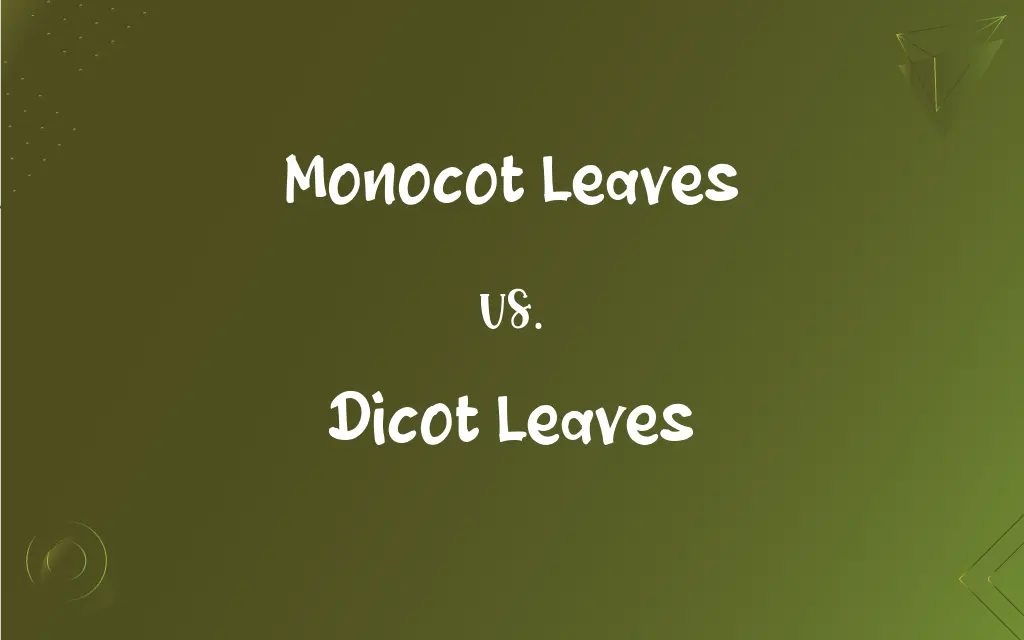Monocot Leaves vs. Dicot Leaves: What's the Difference?
Edited by Aimie Carlson || By Janet White || Published on February 17, 2024
Monocot leaves typically have parallel veins and are narrow, while dicot leaves usually feature a branched vein pattern and a wide range of shapes.

Key Differences
Monocot leaves are characterized by their parallel venation, where veins run side by side along the length of the leaf. In contrast, dicot leaves generally display a reticulate or branched venation pattern, with a central main vein from which smaller veins branch out.
The shape of monocot leaves tends to be long and narrow, suited to their parallel vein structure. Dicot leaves, however, come in a variety of shapes, ranging from broad and rounded to deeply lobed, corresponding to their complex venation.
In monocots, the leaf base usually wraps around the stem, a feature known as sheathing, providing structural support. Dicot leaves typically have a distinct petiole (leaf stalk) that attaches the leaf blade to the stem.
The arrangement of stomata, or breathing pores, in monocot leaves is usually more uniform and less varied than in dicots. Dicot leaves often have a more irregular stomatal pattern, with differing densities on the upper and lower surfaces.
Monocot leaves are found in plants like grasses, lilies, and palms, reflecting their adaptation to environments from prairies to wetlands. Dicot leaves are seen in a wide range of plants, from oaks and roses to peas and sunflowers, demonstrating their diverse ecological adaptations.
ADVERTISEMENT
Comparison Chart
Vein Pattern
Parallel veins
Branched or reticulate veins
Leaf Shape
Generally long and narrow
Varied shapes (broad, rounded, lobed)
Leaf Base
Often sheathing the stem
Typically with a distinct petiole
Stomata Arrangement
Uniform distribution
Irregular, often different on each surface
Typical Examples
Grasses, lilies, palms
Oaks, roses, peas, sunflowers
ADVERTISEMENT
Monocot Leaves and Dicot Leaves Definitions
Monocot Leaves
Monocot leaves have parallel venation.
The leaves of bamboo, a monocot, show clear parallel veins.
Dicot Leaves
They come in various shapes, including lobed and rounded.
Oak leaves, which are dicots, often have deep lobes.
Monocot Leaves
They usually have uniformly distributed stomata.
Onion leaves, typical monocots, have evenly spaced stomata.
Dicot Leaves
Dicot leaves are found in a wide range of plants.
The broad leaves of sunflowers are characteristic of dicots.
Monocot Leaves
They are typically long and narrow in shape.
Corn plants, which are monocots, have slender leaves.
Dicot Leaves
Dicot leaves have a distinct petiole.
Rose leaves are attached to the stem by a petiole.
Monocot Leaves
Monocot leaves often sheath the stem.
Wheat leaves wrap around the stem at their base.
Dicot Leaves
Stomata distribution in dicot leaves is irregular.
Tomato leaves, being dicots, have varying stomatal densities.
Monocot Leaves
Monocot leaves are found in grasses and lilies.
The leaves of tulips, a type of lily, are monocotyledonous.
Dicot Leaves
Dicot leaves feature branched venation.
Maple leaves, with their intricate vein patterns, are dicots.
FAQs
What defines dicot leaves?
Dicot leaves come from dicotyledonous plants and have branched or reticulate venation.
How do monocot leaves attach to the stem?
Many monocot leaves have a sheathing base that wraps around the stem.
What are monocot leaves?
Monocot leaves are leaves from monocotyledonous plants, characterized by parallel veins.
Can you give an example of a plant with monocot leaves?
Grasses and lilies are examples of plants with monocot leaves.
Can dicot leaves be identified by their vein pattern alone?
The branched vein pattern is a strong indicator, but other features should also be considered for identifying dicot leaves.
How do dicot leaves differ in shape?
Dicot leaves vary widely in shape, including broad, rounded, and lobed forms.
What is the typical shape of monocot leaves?
Monocot leaves are usually long and narrow.
Are dicot leaves found in a specific environment?
Dicot leaves are found in diverse environments, reflecting the wide range of dicotyledonous plants.
Is parallel venation exclusive to monocot leaves?
While typical, parallel venation is not exclusive to monocots but is a key characteristic.
What is unique about the petiole in dicot leaves?
Dicot leaves typically have a distinct petiole that connects the leaf blade to the stem.
Is venation the only way to differentiate monocot and dicot leaves?
Venation is a primary method, but other features like leaf shape, petiole structure, and stomata distribution are also important.
Do monocot leaves have secondary growth?
Monocot leaves typically do not exhibit secondary growth.
Are stomata evenly distributed in monocot leaves?
Yes, stomata are usually uniformly distributed in monocot leaves.
Do all monocot leaves sheath the stem?
Many, but not all, monocot leaves have a sheathing leaf base.
Are there exceptions to the typical shapes of dicot leaves?
Yes, while varied, some dicot leaves may have simpler shapes, similar to monocots.
How is the stomatal pattern in dicot leaves?
Dicot leaves often have an irregular stomatal pattern, with different densities on each surface.
Do monocot leaves have a wide range of shapes?
No, monocot leaves generally do not have as wide a range of shapes as dicot leaves.
What are some examples of plants with dicot leaves?
Oaks, roses, and sunflowers are examples of plants with dicot leaves.
Are dicot leaves generally larger than monocot leaves?
Dicot leaves can be larger, but this varies widely among species.
Can the environment influence the structure of monocot and dicot leaves?
Yes, environmental factors can influence the structural adaptations of both monocot and dicot leaves.
About Author
Written by
Janet WhiteJanet White has been an esteemed writer and blogger for Difference Wiki. Holding a Master's degree in Science and Medical Journalism from the prestigious Boston University, she has consistently demonstrated her expertise and passion for her field. When she's not immersed in her work, Janet relishes her time exercising, delving into a good book, and cherishing moments with friends and family.
Edited by
Aimie CarlsonAimie Carlson, holding a master's degree in English literature, is a fervent English language enthusiast. She lends her writing talents to Difference Wiki, a prominent website that specializes in comparisons, offering readers insightful analyses that both captivate and inform.






































































